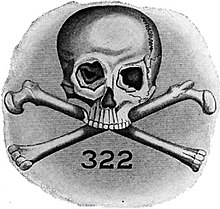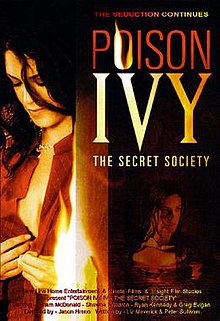A secret society is a club or organization whose activities, events, and inner functioning are concealed from non-members. The society may or may not attempt to conceal its existence. The term usually excludes covert groups, such as intelligence agencies or guerrilla insurgencies, that hide their activities and memberships but maintain a public presence. The exact qualifications for labeling a group as a secret society are disputed, but definitions generally rely on the degree to which the organization insists on secrecy, and might involve the retention and transmission of secret knowledge, denial of membership or knowledge of the group, the creation of personal bonds between members of the organization, and the use of secret rites or rituals which solidify members of the group.
Anthropologically and historically, secret societies are deeply interlinked with the concept of the Mannerbund, the all-male "warrior-band" or "warrior-society" of pre-modern cultures (see H. Schurtz, Alterklassen und Mannerbunde, Berlin, 1902; A. Van Gennep, The Rites of Passage, Chicago, 1960).
A purported "family tree of secret societies" has been proposed, although it may not be comprehensive.
Alan Axelrod, author of the International Encyclopedia of Secret Societies and Fraternal Orders, defines a secret society as an organization that:
- Is exclusive.
- Claims to own special secrets.
- Shows a strong inclination to favor its own.
David V. Barrett, author of Secret Societies: From the Ancient and Arcane to the Modern and Clandestine, uses slightly different terms to define what does and does not qualify as a secret society. He defines it as any group that possesses the following characteristics:
- It has "carefully graded and progressed teachings"
- Teachings are "available only to selected individuals"
- Teachings lead to "hidden (and 'unique') truths"
- Truths bring "personal benefits beyond the reach and even the understanding of the uninitiated."
Barrett goes on to say that "a further characteristic common to most of them is the practice of rituals which non-members are not permitted to observe, or even to know the existence of." Barrett's definition would rule out many organizations called secret societies; graded teaching is usually not part of the American college fraternities, the Carbonari, or the 19th century Know Nothings.
Politics

Since some secret societies have political aims, they are illegal in several countries. Poland, for example, has included a ban of secret political parties and political organizations in its constitution.
Revolutions
Because of the targeting of revolutionary activists in authoritarian regimes, some groups have formed secret & anonymous societies to take leadership without the risk of harassment by the authorities. An example would be the Bahraini February 14 Youth Coalition.
Colleges and Universities

Many student societies established on university campuses in the United States have been considered secret societies. Perhaps one of the most famous secret collegiate societies is Skull and Bones at Yale University. The influence of undergraduate secret societies at colleges such as Harvard College, Dartmouth College, University of Virginia, New York University, and Wellesley College has been publicly acknowledged, if anonymously and circumspectly, since the 19th century.
British Universities, too, have a long history of secret societies or quasi-secret societies, such as The Pitt Club at Cambridge University, Bullingdon Club at Oxford University, and the 16' Club at St David's College.
One of the best known British secret societies is the Cambridge Apostles, founded as an essay and debating society in 1820. Notable examples in Canada include Episkopon at the University of Toronto's Trinity College, and the Society of Thoth at the University of British Columbia.
Secret societies are disallowed in a few colleges. Virginia Military Institute has rules that no cadet may join a secret society, and secret societies have been banned at Oberlin College from 1847 to the present, and at Princeton University since the beginning of the 20th century.
Internet
While their existence had been speculated for years, internet-based secret societies first became known to the public in 2012 when the secret society known as Cicada 3301 began recruiting from the public via internet-based puzzles. The goals of the society remain unknown, but it is believed they are involved in cryptography and cryptocurrency.
References

Further reading

- Heckethorn, Charles William (1886). The Secret Societies of All Ages and Countries, Embracing the Mysteries of Ancient India, China, Japan, Egypt, Mexico, Peru, Greece, and Scandinavia, the Cabbalists, Early Christians, Heretics, Assassins, Thugs, Templars, the Vehm and Inquisition, Mystics, Rosicrucians, Illuminati, Freemasons, Skopzi, Camorristi, Carbonari, Nihilists, and Other Sects (2nd ed.). Forgotten Books. ISBNÂ 978-1-4400-8999-2.Â
- Whalen, William Joseph (1966). Handbook of Secret Organizations. Milwaukee: Bruce Pub. Co. LCCNÂ 66026658.Â
- Axelrod, Alan (1997). The International Encyclopedia of Secret Societies and Fraternal Orders. New York: Facts on File. ISBNÂ 0-8160-2307-7.Â
- Harwood, W. S. "Secret Societies in America," The North American Review, Vol. 164, No. 486, May, 1897.
- Hodapp, Christopher; Von Kannon, Alice (2008). Conspiracy Theories and Secret Societies For Dummies. Wiley. ISBNÂ 0-470-18408-6.Â
- Jacob, Frank (2012). Geheimgesellschaften: Kulturhistorische Sozialstudien: Secret Societies: Comparative Studies in Culture, Society and History. Würzburg: Königshausen & Neumann. ISBN 978-3826049088.Â
- Kloosterman, Jaap (2013). Secret Societies. Leibniz Institute of European History (IEG).Â
- Roberts, J. M. (John Morris) (1972). The Mythology of the Secret Societies. New York: Scribner. ISBNÂ 0-684-12904-3.Â
- Robbins, Alexandra (2004). Pledged: The Secret Life of Sororities. New York: Hyperion. ISBNÂ 0-7868-8859-8.Â
- Stevens, Albert Clark (1899). The Cyclopædia of Fraternities. New York: Hamilton Printing & Publishing Company.Â
- Stephen Klimczuk, Gerald Warner (2009). Secret Places, Hidden Sanctuaries: Uncovering Mysterious Sights, Symbols, and Societies, New York: Sterling Publishing Company.
External links
- Secret Societies: a very short history â€" Documents and illustrations of Freemasons, Jesuits, Illuminati, Carbonari, Burschenschaften and other putative secret societies and clandestine organizations
- Stevens, The cyclopædia of fraternities (2nd ed.). A comprehensive, though dated, review of the subject.

